Speech What are the Global Imbalances?
1. Introduction
I have given a number of speeches to the Economic Society over the years, and it is a pleasure to be doing so again tonight. The last time I gave the closing address to the Conference of Economists was in 1997 in Hobart. The subject I want to speak about tonight is one which has loomed particularly large in international macro-economic discussion in the period since then. I refer to the subject of global imbalances in international payments.
Most of the discussion, at least until quite recently, focussed on the large US current account deficit and questioned its sustainability and the risks it posed to the world economy. Tonight I would like to approach the subject of global payments imbalances from a broader perspective. In doing so, the focus of attention is shifted towards Asia, recognition is given to the weakness of Europe, and the United States is cast into an accommodating role, rather than an initiating one.
When we look at the global economy over the past half dozen years, there are a number of developments that have been difficult to satisfactorily understand and explain. I suggest that the following five developments are the central ones in need of an explanation.
- Why did the US current account deficit start to widen sharply after 1997, reach such a high percentage of GDP, and yet has been relatively easily financed?
- Why has Asia run such large current account surpluses and built up such a high level of international reserves?
- Why did the world's central banks push short-term interest rates to their lowest level for a century, and why has this apparently easy monetary policy not led to an appreciable pick-up in inflation?
- Why have bond yields been so low, and why have they stayed low even when short-term interest rates have been raised?
- Against this background of wide payments imbalances, why have the margins for risk in corporate and emerging market debt been so exceptionally low?
A number of explanations have been put forward to account for each of these developments. The most common explanation has started with the widening US current account deficit, and attributed it mainly to excessive spending and borrowing and insufficient saving by US households and the US Government[1]. While this explanation is consistent with the widening US current account deficit, it has a number of shortcomings because it is inconsistent with some other developments we observe in the global economy. For an explanation to have any plausibility, it must be consistent with all the five simultaneous developments listed above.
In my view, the most promising explanation at present is one which starts with the surplus countries and focuses on why national savings are so much higher than national investment in those countries.[2] Although it is not, in itself, a complete explanation of everything that has happened, it is the most plausible in that it is consistent with all the five developments listed above.
2. The excess of savings in the surplus countries
The best starting point for any explanation is to recognise that there is a wide disparity between saving rates in different countries. Broadly speaking, Asian countries tend to have high saving rates, Anglo-Saxon ones low saving rates, and other countries somewhere in between (row 1 of Table 1). For balance of payments purposes, this would not matter if investment rates in each country matched the saving rate, but this is not the case (row 2 of Table 1). In countries with high saving rates, investment rates, while high, are not as high as the saving rate, and these countries run a current account surplus. The opposite applies in the low saving countries. To understand developments in current accounts, we have to understand developments in saving and investment ratios in different countries and regions.
| Asia | |||||||
|---|---|---|---|---|---|---|---|
| US | Other anglosphere(a) |
Euro area | Japan | China | Other east Asia |
||
| Saving | 15.1 | 17.7 | 21.0 | 27.6 | 43.7 | 29.8 | |
| Investment | 19.3 | 18.9 | 20.5 | 24.8 | 40.9 | 24.4 | |
|
(a) Australia, Canada, New Zealand, United Kingdom Sources: CEIC; IMF; RBA; Thomson Financial |
|||||||
In short, Asian countries have more savings than they wish to invest in their own countries, and so they have to invest or lend abroad. This is the most basic of all balance of payments identities. Other countries that invest more than they save have to finance their investment by using the savings of foreigners. The actual channel can take many forms, but that is not crucial to the story.
To complicate the story slightly, it is not only Asian countries that are running surpluses at the moment. As a result of the high oil price, the Middle East and Russia are also doing so, as are the Latin American countries for different reasons. While acknowledging these surpluses, I intend to leave them out of the rest of my account on the grounds that they are a good deal smaller than in Asia, and that, on past experience, they are likely to be temporary. For those who want to follow them up, I recommend a recent paper on our website.[3]
Returning to Asia, we can ask why these countries do not invest more in themselves, and can find several explanations which I will outline later. Whatever the explanation, we should probably accept that in the medium term, a surplus of Asian saving over Asian domestic investment will be a fact of life; hence, Asia will run large current account surpluses and therefore will have an excess supply of savings to be invested abroad.
Given that this is going to happen, some other countries must run deficits – this is another important balance of payments identity which must hold. If no other country was prepared to run a deficit, then the world economy would enter a downward spiral with ex ante saving greater than ex ante investment. Clearly, the countries that will run the deficits will be those where consumers, businesses and governments are most willing to spend and whose financial systems are most efficient at intermediating the flow of world savings.
For ease of exposition, we can focus on three main regions of the world – Asia, the Euro area and the anglosphere (mainly the United States, but also the United Kingdom, Canada, Australia and New Zealand). Asia runs a large current account surplus, and we might expect it to be balanced by deficits in the other two regions. In fact, the entire deficit shows up in the Anglosphere, with the Euro area in approximate balance. While balance sounds like a good thing, the Euro area has achieved this largely because of weak domestic demand and high unemployment over recent years. So what appears to be a balance in European payments, is in fact an important imbalance in the global economy.
| anglosphere(a) | Asia | ||||||
|---|---|---|---|---|---|---|---|
| Total | United States | Euro area | Japan | China | Other east Asia |
||
| Per cent of GDP | −4.7 | −5.7 | 0.5 | 3.7 | 4.2 | 6.3 | |
| US$ billion | −734 | −668 | 47 | 172 | 69 | 118 | |
|
(a) Australia, Canada, New Zealand, United Kingdom, United States Source: IMF |
|||||||
As explained before, the Asian surplus has to be invested in the rest of the world, and it will tend to flow to those regions which offer the highest return on capital. While foreign investment flows both ways, in net terms it has flowed from Asia mainly to the United States and has underpinned the level of the US dollar, despite the US current account deficit, and provided easy access to finance for US borrowers in the business, household and government sectors.
3. How does this explanation fit the five questions?
(i) The ease of financing the US current account deficit
There have been widespread fears expressed over the past half dozen years that the United States would have difficulty financing its deficit, that the US dollar would fall sharply, and that real interest rates in the United States would rise as borrowers competed for funds. In fact, the US current account deficit has been relatively easily financed despite it continuing for fifteen years and reaching 6 per cent of GDP. The US dollar in real effective terms today is at or slightly above its level of fifteen years ago when the recent run of deficits started (Graph 1). Although it has fallen in net terms since its early 2002 peak, this has only unwound its rise since the mid 1990s. This is not what one would expect for a country having difficulty attracting the funds to finance its deficit. Similarly, the real interest rate at which borrowing has occurred is a lot lower than a decade ago, a subject I will address later. Overall, the US experience is consistent with a plentiful supply of internationally-mobile savings rather than one where it has had to struggle to find the funds to finance its spending.
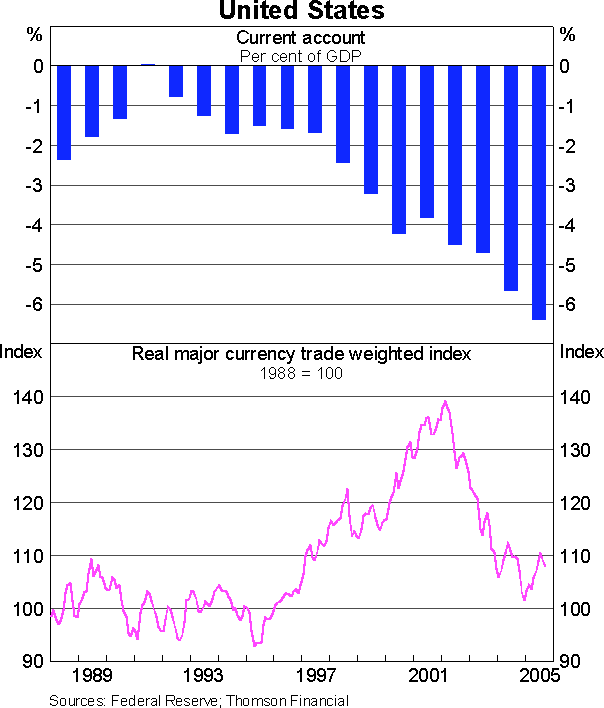
(ii) The continuation of Asian surpluses
This is the starting point of my explanation, not something that has to be explained by the other developments. Even so, it is of some interest to know why Asian countries seem content with the situation.
Although there are some common factors among these countries, there are also some interesting differences. Japan is the easiest to deal with as it has had a large surplus for a long time, as you would expect from a high-income country with a rapidly-ageing population. But the situations of China and other East Asia are more interesting as they have only moved into significant surplus over the past half dozen years.
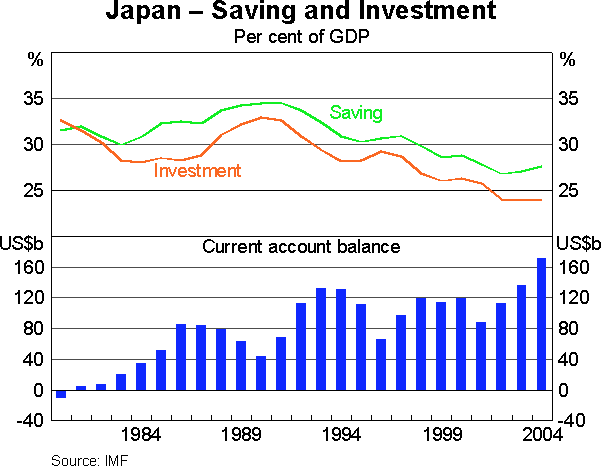
In the case of other East Asia, I think it is very clear that this occurred as a reaction to the pain they suffered during the Asian crisis of 1997/98. Both the Asian private and government sectors cut back sharply and this shows up as a fall in the investment ratio of about 7 or 8 per cent of GDP to a lower level, at which it has stayed (see Graph 3). The governments of the region reached the conclusion that they “had to make their economies more resilient to international capital flows. The simplest way of doing this was to cut expenditure (particularly investment expenditure), keep savings high, run current account surpluses and build up international reserves.”[4]
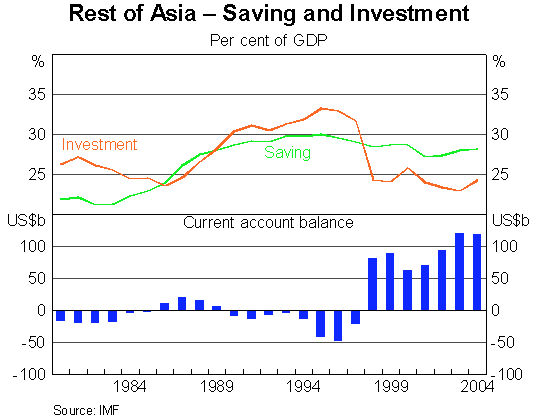
In China's case, the story is more complicated.[5] It did not suffer in the Asian crisis, but it still absorbed the same lesson as the countries that did. That is one of the reasons that China has chosen to run current account surpluses and build international reserves. But a more over-riding reason is the awareness by its government that, as a result of its economic liberalisation, it has to create about 20 million jobs per year just to absorb the exodus of workers from the countryside. In other words, it has to run its economy at an exceptionally fast pace, and is reluctant to adopt policies which might run counter to this aim in the short run, even if they would contribute to maintaining longer-run sustainability.
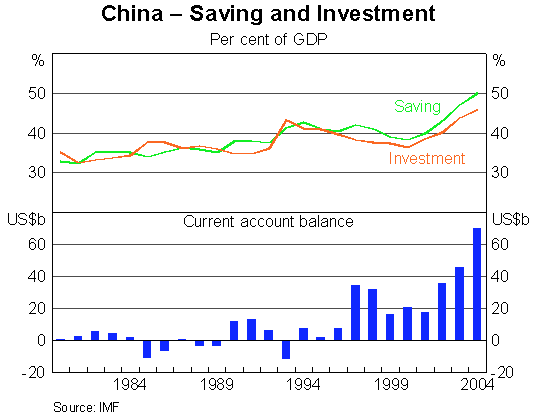
I think historians will regard the economic liberalisation of China as the major economic event of the past 30 years, with its effects showing up in countries and economic variables that at first sight seem remote from it. To date, the size of the Chinese surpluses have been smaller than for Japan and other East Asia, but China's influence in other ways has been greater. All Asian countries are acutely aware of their level of competitiveness vis-à-vis China, both in international trade and investment, and this is an additional reason why they have resisted appreciations of their own currencies. The rapid increase in Chinese manufactured output and exports, based on its exceptionally low labour costs, has affected its competitors in Asia as much as its customers such as the United States.
(iii) Low central bank interest rates
The high supply of Asian savings is not the explanation for the sharp fall in central-bank-determined interest rates in 2001 and 2002. That fall was a response by central banks in the developed countries to the collapse of the global equity market boom and associated recession that occurred in most of their countries. But the interesting question is why did those interest rates go so low; for the United States , Japan and the Euro area they fell below their 1930s levels. And why have they stayed so low, even accepting that the United States has gone some way to restoring them to a more neutral level? The answer has to be that inflation has remained so low. If inflation had picked up in the way that it did in earlier cyclical recoveries, central-bank-determined interest rates would have risen more by now.
So the real issue is why have inflationary pressures stayed so low? An ex ante excess supply of world saving means that it would be unlikely for a situation of generalised excess demand in the world's goods markets to occur, and hence for inflationary pressures to emerge. Another way of thinking about this is to remember that a surplus of savings in a given country means that the country is producing more goods and services than it absorbs in domestic spending. In China's case, there has been a massive increase in its capacity to produce manufactured goods, and its domestic spending has not kept pace with the expansion in supply. The result has been a rapidly growing supply of low-cost manufactured goods supplied by China to the rest of the world. The same has been true on a smaller scale for other Asian countries running surpluses. The increased productive capacity in China and other parts of Asia can be seen as part of the mechanism by which their trade and current account surpluses have been exerting downward pressure on global inflation.
(iv) Why bond yields have remained at historically low levels
The fact that bond yields have remained low despite rising oil prices and the Fed raising short-term interest rates is really the nub of the issue. If excessive US spending and inadequate saving were the main story affecting the world economy, bond rates would be rising not falling. Clearly, developments in the bond market are far more consistent with a world of plentiful saving than one of excessive spending and borrowing.
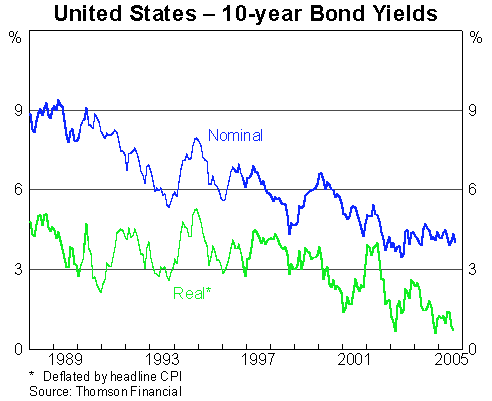
The low level of nominal interest rates may be partly explained by the forces already cited which have held down inflation. But real interest rates have also fallen to extremely low levels.[6] (Graph 5). Thus, it is not only inflation and inflationary expectations that are at work – the real demand and supply for borrowed funds must have changed. In economic terms, a fall in price suggests that the supply curve of saving has moved outwards relative to the demand curve.
(v) Why risk margins have narrowed
Again, this is entirely consistent with a world of excess supply of funds looking for attractive yields. With yields on high quality government paper having been driven down to low levels, investors have been attracted to other securities that can offer something higher. Thus, margins on all grades of corporate debt and emerging market debt have been driven down. This has occurred despite the recent history of US corporate scandals and the default by Argentina, which would normally have heightened perceptions of risk in these securities. Of course, this search for yield has not just affected debt; it also explains rising prices on assets of all types from houses to equities as investors take advantage of low borrowing costs and seek alternative investments.
4. Two counterfactuals
Some observers may think that in my explanation of global developments, US profligacy and excessive reliance on debt have been let off too lightly. What, they may ask, would have happened if increased US spending and reduced savings had not been accommodated by Asian saving and lending? The answer is that the increased US spending and lower US saving would not have occurred, or would only have occurred on a greatly reduced scale.
If the excess world saving had not been available, the global economy would have been in the opposite position, namely excess demand in goods and capital markets. US demand for funds would have pushed up bond rates, inflationary pressures would mean US monetary policy would be tighter, and the US Government would have difficulty funding its budget deficit. Businesses and households in the United States would face tougher monetary and fiscal policies and spending would be more restrained. Despite higher US interest rates, the US dollar would probably be weaker because foreign demand for US assets would be lower. The US current account deficit would be smaller due to the weaker domestic demand and lower US dollar.
It is not clear whether the world economy would be weaker or stronger. On the one hand, the extra Asian spending would have pushed up world demand. On the other hand, higher inflation, higher world interest rates and reduced US spending would have held it down. But the imbalances in international payments would have been smaller.
I do not want to give the impression that the large US current account deficit is not an imbalance, or that it can go on rising forever. Clearly, that is not the case. My view is only that we should not start our analysis with the US current account, or look to its remediation as the key to unwinding the imbalances. For example, the most commonly heard prescription is for the United States to reduce its call on world savings by reducing its fiscal deficit. However, if my analysis is correct, a reduction in the US fiscal deficit by itself would be unlikely to have a major impact on international imbalances.[7] In the absence of policy changes in Asia, the Asian countries would be likely to continue running surpluses, and so a fiscal contraction in the United States would only add a contractionary influence to a global economy already characterised by surplus saving and unusually low interest rates.
Another view that has recently been put is that it was excessively loose monetary policy rather than saving/investment imbalances that was at the heart of the problem. This view is generally bolstered by some reference to excessive liquidity, although the concept is left undefined. I do not find this argument at all convincing. There is no doubt that world interest rates have been exceptionally low, but does that of itself mean that monetary policy has been exceptionally loose? To maintain this view, you would have to believe, for example, that monetary policy in Japan and Europe , where there has been weak demand growth and negligible inflation for a number of years, should have been tightened, i.e. European and Japanese interest rates should have been raised. This would make no sense. The low level of interest rates in most developed countries is not the first cause of the global imbalances, it is the result of them.
5. Conclusions
In making Asia the focus of my account, I hope I did not give the impression that I am blaming Asia for the imbalances. This is not the case, partly because I have never been a pessimist about the sustainability of the imbalances, and partly because I can sympathise with much of the recent Asian experience, particularly during the Asian crisis. My account takes its form purely from the fact that it is the only one that seems to me to be consistent with the five questions I posed at the beginning. It is the only one that explains why there is downward pressure on CPI inflation and interest rates, and in consequence upward pressure on asset prices. As a central banker, I cannot complain about these events because they have made my central task of maintaining low inflation easier. Similarly, as an Australian, I can see that the impressive economic development of Asia has benefited our complementary economy in many ways.
I have not provided any assessment of the risks involved in the current situation because that would involve another talk at least as long as tonight's. But, if it is any reassurance, I think we are seeing some early signs of a return to normality, even if they are small and the process likely to be a long one. The Fed's policy of gradually moving up US interest rates towards neutrality is the most obvious sign. The other one is China's abandonment of its fixed parity to the US dollar. Although its upward movement so far is extremely modest, they have clearly set the direction for the future. To me, it is an extremely significant move and suggests that they will countenance policy changes which in the short run might slightly restrain demand, but in the long run increase the chances of sustainable growth.
Endnotes
See Mann (1999 and 2002), Obsfeld and Rogoff (2000 and 2004) and Peterson (2004). [1]
Ben Bernanke, while a Governor of the US Federal Reserve Board, gave the best explanation along these lines. He originally called it the “glut of savings” argument, but it could more appropriately be called the “dearth of investment” argument because there has not really been an increase in world savings, only a redistribution. Alternatively, we could call it the “glut of savings in surplus countries” argument. See Bernanke (2005A, 2005B). [2]
For a fuller account of these developments, see Orsmond (2005) and IMF (2005). [3]
Macfarlane (2005). [4]
See Dooley, Folkerts-Landau and Garber (2003 and 2005) for an interesting account of the Asian approach to balance of payments adjustment. [5]
Only in periods of unanticipated sharp rises in inflation have they been lower. [6]
Bernanke (2005A) reported a Federal Reserve study which estimated that balancing the federal budget would reduce the current account deficit in the medium term by less than 1 per cent of GDP. The IMF estimate that a permanent 1 percentage point of GDP improvement in the US budgetary position would lower the current account deficit by ½ of one per cent of GDP. [7]
Bibliography
Bernanke B, “The Global Saving Glut and the US Current Account Deficit,” The Sandridge Lecture, Virginia Association of Economists, Richmond, Virginia, March 2005; subsequently updated in the Homer Jones Lecture, St. Louis, Missouri, April 2005.
Cooper R, “The US Current Account Deficit: Is it Sustainable?” Strategic Economic Decisions Inc, September 2005.
Dooley M, Folkerts-Landau D and Garber P, “An Essay on the Revised Bretton Woods System,” NBER Working Paper No. 9971, September 2003.
Dooley M, Folkerts-Landau D and Garber P, “Savings Gluts and Interest Rates: The Missing Link to Europe,” NBER Working Paper No. 11520, August 2005.
International Monetary Fund, “Global Imbalances: A Saving and Investment Perspective,” in World Economic Outlook, Washington DC, September 2005.
Macfarlane IJ, “Payments Imbalances,” Speech to Chinese Academy of Social Sciences, Beijing, May 2005, China & World Economy, Vol 13. No 5. Available at <https://www.rba.gov.au>
Mann C, Is the US Trade Deficit Sustainable?, Institute for International Economics, Washington DC, 1999.
Mann C, “Perspectives on the US Current Account Deficit and Sustainability,” Journal of Economic Perspectives, Vol 16, Summer 2002.
Obstfeld M and Rogoff K, “Perspectives on OECD Integration: Implications for US Current Account Adjustment,” in Global Economic Integration: Opportunities and Challenges, Federal Reserve Bank of Kansas City, 2000.
Obstfeld M and Rogoff K, “The Unsustainable Current Account Position Revisited,” NBER Working Paper 10869, November 2004.
Orsmond D, “Recent Trends in World Saving and Investment Patterns,” in Reserve Bank of Australia Bulletin, October 2005 (forthcoming). Available at <https://www.rba.gov.au>
Peterson P, “Riding for a Fall,” Foreign Affairs, September/October 2004.
